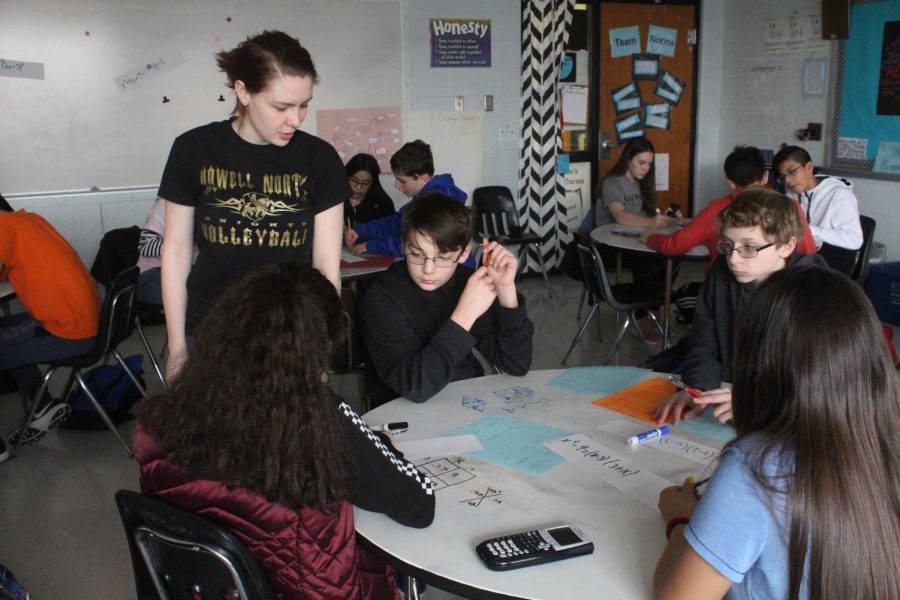New Math Curriculum, CPM, Has Students Learning From a Book Rather Than Being Lectured
Credit to Anna Hollinger
Math teacher Hannah Snyder-Laws, looks over students’ work during her Algebra class. The curriculum has students working together in teams to solve problems and complete the lesson for that day.
Published: April 9, 2019
Selected high school math students started a new curriculum last year by College Preparatory Mathematics. CPM is a company that created a new math curriculum called Core Connections. Core Connections allows students to learn off other students in conversing about math.
“The curriculum is what’s right for kids,” math teacher Christine Edwards said. ”I love the interaction between the students and how they take responsibility for their own personal learning.”
Unlike the traditional method of the teacher standing up at the board teaching or lecturing while the class listens and takes notes, students are actively learning. Students are placed in a group of four at a table. Each table has a few textbooks that hold all the questions including homework. The problems students do in class are called Core Problems. The Core Problems are usually five to eight questions that are related to the unit they are currently on. The goal is to learn something new everyday through working with peers.
“As well as the students, I am constantly learning new things,” Edwards said. ”Things I would have never thought of to get the answer.”
Students have homework almost every night. Homework is typically online, but some teachers print it out to make it easier to grade and go over at the beginning of class. While doing homework online, if you click on the question expands it and you can get extra help. Homework help sometimes gives the answer without steps to get the student actively learning, which can lead to poor test scores. Most of the time, homework help gives steps leading to the answer so the student will get a better understanding of how the problem was solved. This way they are more engaged.
“I’m seeing students remember more things from the earlier chapters rather than the traditional,” math teacher Hannah Snyder-Laws said.
According to Snyder-Laws, this new addition has changed the way of learning of the students who actually put forth the effort. Learning is not in the teachers hands anymore, it is on the students for how well they do their work and how much they pay attention.
“I think the new curriculum helps your memory and your working with a group so you’re getting other students perspectives,” sophomore Sydney Giacomarra said.
While students like Giacomarra like it, other students are not very fond of the new curriculum because they are either not used to it and like the traditional method a lot better, or they are frustrated because they don’t know exactly what they are doing and claim they are not learning. On the other hand, teachers are seeing a difference with the class, so it could be benefiting the students.
“It increases communication skills while learning,” Edwards said. “It also makes math fun for all kids.”






![2024 Graduation [Photo Gallery]](https://FHNtoday.com/wp-content/uploads/2024/06/IMG_5917-300x200.jpg)
![Class of 2024 Wave Goodbye at the Senior Wave [Photo Gallery]](https://FHNtoday.com/wp-content/uploads/2024/05/IMG_9048-300x200.jpg)

![Seniors Attend Senior Breakfast and Graduation Practice [Photo Gallery]](https://FHNtoday.com/wp-content/uploads/2024/05/IMG_0169-300x200.jpg)
![The 2024 Senior Class Conducts A Wedding Ceremony [Photo Gallery]](https://FHNtoday.com/wp-content/uploads/2024/05/IMG_1213-300x200.jpg)